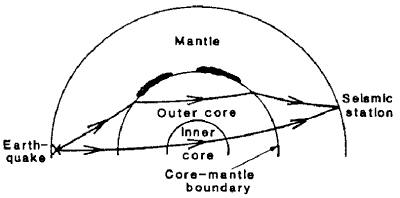 |
Science Frontiers ONLINE No. 47: Sep-Oct 1986 |
|
|
Continental graveyard?
The seismic waves generated by earthquakes penetrate deeply into our planet and allow geophysicists to, in effect, X-ray the earth. In addition to the hypothesized solid inner core, the fluid outer core, and the encapsulating solid mantle, there seems to be continentsized inhomogeneities in the vicinity of the mantle and the outer core. The anomalous seismic signals can be interpreted as huge blocks of different composition and/or temperature.
T.H. Jordan, from MIT, ventures:
"...that what they have mapped are 'continents' on the core-mantle boundary. 'What we've seen is something really incredible,' he says. According to Jordan, the anomalies are analogous to continents on the surface of the earth, because they can't be accounted for by temperature variations but must reflect some compositional change as well. These features 'represent the scum or slag that sits up on the outer core boundary, just as continents sit on the outer surface of the earth,' he says."
Some have even speculated that these subterranean chunks of debris are pieces of surface continents that were subducted at the plate boundaries long ago. There are, after all, missing pieces in the continental drift jigsaw puzzle. There might even be substantial chunks of asteroids and comets down there waiting, like the Titanic, to be explored by scientific instruments. Can once-subducted continents and cosmic debris ever rise again?
(Weisburd, Stefi; "Seismic Journey to the Center of the Earth," Science News, 130:10, 1986. Also: Kerr, Richard A.; "Continents at the Core-Mantle Boundary?" Science, 233:523, 1986.)
 |
Earthquake waves allow seismologists to construct models of the earth's interior. Coninent-sized inhomogenities have been found near the core-mantle boundary. |